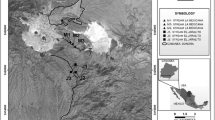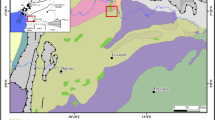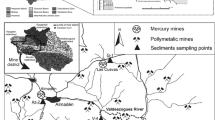Abstract
Purpose
Despite the decline of metal mining in the UK during the early 20th century, a substantial legacy of heavy metal contamination persists in river channel and floodplain sediments. Poor sediment quality is likely to impede the achievement of ‘good’ chemical and ecological status for surface waters under the European Union Water Framework Directive. This paper examines the environmental legacy of the Dylife lead/zinc mine in the central Wales mining district. Leachable heavy metal concentrations in the bed sediments of the Afon Twymyn are established and the geochemical partitioning, potential mobility and bioavailability of sediment-associated heavy metals are established.
Materials and methods
Sediment samples were collected from the river bed and dry-sieved into two size fractions (<63 and 64–2,000 µm). The fractionated samples were then subjected to a sequential extraction procedure to isolate heavy metals (Pb, Zn, Cu, Cd, Fe, Mn) in three different geochemical phases. Sediment samples were then analysed for heavy metals using Inductively Coupled Plasma-Atomic Emission Spectroscopy (ICP-AES).
Results and discussion
The bed sediment of the Afon Twymyn is grossly polluted with heavy metals. Within the vicinity of the former mine, Pb concentrations are up to 100 times greater than levels reported to have deleterious impacts on aquatic ecology. Most heavy metals exist in the most mobile easily exchangeable and carbonate-bound geochemical phases, potentially posing serious threats to ecological integrity and constituting a significant, secondary, diffuse source of pollution. Metal concentrations decrease sharply downstream of the former mine, although there is a gradual increase in the proportion of readily extractable Zn and Cd.
Conclusions
Implementation of sediment quality guidelines is important in order to achieve the aims of the Water Framework Directive. Assessments of sediment quality should include measurements of background metal concentrations, river water physico-chemistry and, most importantly, metal mobility and potential bioavailability. Uniformity of sediment guidelines throughout Europe and flexibility of targets with regard to the most heavily contaminated mine sites are recommended.






Similar content being viewed by others
References
Aleksander-Kwaterczak U, Helios-Rybicka E (2009) Contaminated sediments as a potential source of Zn, Pb, and Cd for a river system in the historical metalliferous ore mining and smelting industry area of South Poland. J Soils Sediments 9:13–22
Armitage PD, Bowes MJ, Vincent HM (2007) Long-term changes in macroinvertebrate communities of a heavy metal polluted stream: the River Nent (Cumbria, UK) after 28 years. River Res Appl 23:997–1015
Bick DE (1977) The old metal mines of mid-Wales. Part 4. West Montgomeryshire, Gloucester
Brils J (2008) Sediment monitoring and the European water framework directive. Ann Ist Super Sanita 3:218–223
British Geological Survey (2007) British regional geology: Wales. British Geological Survey, Keyworth
British Geological Survey (2000) Regional geochemistry of Wales and part of west-central England: stream sediment and soil. British Geological Survey, Keyworth
British Standards Institution (2006) BS ISO 11464:2006. Soil quality—pretreatment of samples for physico-chemical analysis. British Standards Institution, London
Brown M (2006) Dylife. The industrial and social history of a famous Welsh lead mine. Y Lolfa Cyf, Ceredigion
Butler BA (2009) Effect of pH, ionic strength, dissolved organic carbon, time, and particle size on metals release from mine drainage impacted streambed sediments. Water Res 43:1392–1402
Byrne P, Reid I, Wood PJ (2009) Short-term fluctuations in heavy metal concentrations during flood events through abandoned metal mines, with implications for aquatic ecology and mine water treatment. In: Proceedings of the International Mine Water Conference, 19–23 October 2009, International Mine Water Association, Pretoria, South Africa. CD-ROM 124-902, ISBN 978-0-09802623-5-3, http://www.imwa.info/publications/symposium_2009.php
Calmano W, Hong J, Förstner U (1993) Binding and mobilisation of heavy metals in contaminated sediments affected by pH and redox potential. Water Sci Technol 28(8–9):223–235
Comber SDW, Merrington G, Sturdy L, Delbeke K, van Assche F (2008) Copper and zinc water quality standards under the EU Water Framework Directive: the use of a tiered approach to estimate the levels of failure. Sci Total Environ 403(1):12–22
Crane M (2003) Proposed development of sediment quality guidelines under the European Water Framework Directive: a critique. Toxicol Lett 142:195–206
Dawson EJ, Macklin MG (1998) Speciation of heavy metals on suspended sediment under high flow conditions in the River Aire, West Yorkshire, UK. Hydrol Process 12:1483–1494
Dennis IA, Coulthard TJ, Brewer P, Macklin MG (2009) The role of floodplains in attenuating contaminated sediment fluxes in formerly mined drainage basins. Earth Surf Processes Landf 34:453–466
Durance I, Ormerod SJ (2009) Trends in water quality and discharge confound long-term warming effects on river macroinvertebrates. Freshw Biol 54:388–405
Environment Agency (2002) Metal mine strategy for Wales. Environment Agency Wales, Cardiff
Environment Agency (2008a) Assessment of metal mining-contaminated river sediments in England and Wales. Environment Agency, Bristol
Environment Agency (2008b) Abandoned mines and the water environment. Environment Agency, Bristol
Evans AM (1987) An introduction to ore geology, 2nd edn. Blackwell, Oxford
Förstner U (2009) Sediments and priority substances in river basins. J Soils Sediments 9:89–93
Förstner U (2002) Sediments and the European water framework directive. J Soils Sediments 2:54
Förstner U, Salomons W (2008) Trends and challenges in sediment research 2008: the role of sediments in river basin management. J Soils Sediments 8:281–283
Fuge R, Laidlaw IMS, Perkins WT, Rogers KP (1991) The influence of acidic and mine spoil drainage on water quality in the mid-Wales area. Environ Geochem Health 13:70–75
Galan E, Gomez-Ariza JL, Gonzalez I, Fernandez-Caliani JC, Morales E, Giraldez I (2003) Heavy metal partitioning in river sediments severely polluted by acid mine drainage in the Iberian Pyrite Belt. Appl Geochem 18(3):409–421
Gammons CH, Shope CL, Duaime TE (2005) A 24 h investigation of the hydrogeochemistry of baseflow and stormwater in an urban area impacted by mining: Butte, Montana. Hydrol Process 19:2737–2753
Goodyear KL, Ramsey MH, Thornton I, Rosenbaum MS (1996) Source identification of Pb–Zn contamination in the Allen Basin, Cornwall, S.W. England. Appl Geochem 11:61–68
Gower AM, Myers G, Kent M, Foulkes ME (1994) Relationships between macroinvertebrate communities and environmental variables in metal-contaminated streams in south-west England. Freshw Biol 32:199–221
Grimshaw DL, Lewin J, Fuge R (1976) Seasonal and short-term variations in the concentration and supply of dissolved zinc to polluted aquatic environments. Environ Pollut 11:1–7
Hornung M, Adamson JK, Reynolds B, Stevens PA (1986) Influence of mineral weathering and catchment hydrology on drainage water chemistry in three upland sites in England and Wales. J Geol Soc 143:627–634
Jain CK (2004) Metal fractionation study on bed sediments of the River Yamuna, India. Water Res 38:569–578
Jarvis AP, Johnston D, Mayes WM, Potter HAB (2008) Application of a new methodology for assessing the priorities for abandoned mine water pollution remediation at a national scale: results and implications from a study across England and Wales. In: Rapantova N, Hrkal Z (eds) Proceedings of the 10th International Mine Water Association Congress: mine water and the environment, 2–5 June 2008. Karlsbad, Czech Republic
Johnson CC (2005) G-BASE field procedures manual. British geological survey internal report, IR/05/097
Johnson DB (2003) Chemical and microbiological characteristics of mineral spoils and drainage waters at abandoned coal and metal mines. Water Air Soil Pollut 3:47–66
Jones OT (1922) Lead and zinc. The mining district of north Cardiganshire and west Montgomeryshire. British Geological Survey, London
Knott NA, Aulbury JP, Brown TH, Johnston EL (2009) Contemporary ecological threats from historical pollution sources: impacts of large-scale resuspension of contaminated sediments on sessile invertebrate recruitment. J Appl Ecol 46:770–781
Kuwabara J, Berelson W, Balistrieri L, Woods P, Topping B, Steding D, Krabben Hoeft D (2000) Benthic flux of metals and nutrients into the water column of Lake Couer d’Alene, Idaho: report of an August 1999 pilot study. US Geological Survey Water Resources Investigation 00-4132, California
Lewin J, Macklin MG (1987) Metal mining and floodplain sedimentation in Britain. In: Gardiner V (ed) International geomorphology 1986 Part I. Wiley, Chichester, pp 1009–1027
Licheng Z, Guijiu Z (1996) The species and geochemical characteristics of heavy metals in the sediments of Kangjiaxi River in the Shuikoushan Mine Area, China. Appl Geochem 11:217–222
Lopez-Gonzalez N, Borrego J, Morales JA, Carro B, Lozano-Soria O (2006) Metal fractionation in oxic sediments of an estuary affected by acid mine drainage (south-western Spain). Estuar Coast Shelf Sci 68:297–304
Lord RA, Morgan PA (2003) Metal contamination of active stream sediments in Upper Weardale, Northern Pennine Orefield, UK. Environ Geochem Health 25:95–104
Macklin MG (1996) Fluxes and storage of sediment-associated metals in floodplain systems: assessment and river basin management issues at a time of rapid environmental change. In: Anderson MG, Walling DE, Bates P (eds) Floodplain processes. Wiley, Chichester, pp 441–460
Macklin MG, Brewer PA, Hudson-Edwards KA, Bird G, Coulthard TJ, Dennis IA, Lechler PJ, Miller JR, Turner JN (2006) A geomorphological approach to the management of rivers contaminated by metal mining. Geomorphology 79:423–447
Macklin MG, Dowsett RB (1989) The chemical and physical speciation of trace elements in fine grained overbank flood sediments in the Tyne Basin, North-East England. Catena 16:135–151
Mance G, Brown VM, Yates J (1984) Proposed environmental quality standards for list II substances in water—copper. Water Research Centre Technical Report TR210, Wiltshire
Morillo J, Usero J, Gracia I (2002) Partitioning of metals in sediments from the Odiel River (Spain). Environ Int 28(4):263–271
Nagorski SA, Moore JN, Smith DB (2002) Distribution of metals in water and bed sediment in a mineral-rich watershed, Montana, USA. Mine Water Environ 2:121–136
Neal C, Whitehead PG, Jeffrey H, Neal M (2005) The water quality of the River Carnon, west Cornwall, November 1992 to March 1994: the impacts of Wheal Jane discharges. Sci Total Environ 338:23–29
Netzband A et al (2007) Sediment management: an essential element of River Basin Management Plans. J Soils Sediments 7(2):117–132
Nordstrom DK (2003) Negative pH and extremely acidic mine waters from Iron Mountain, California. Environ Sci Technol 34:254–258
Petersen W, Willer E, Williamovski C (1997) Remobilisation of trace elements from polluted anoxic sediments after resuspension in oxic water. Water Air Soil Pollut 99:515–522
Pierre Stecko JR, Bendell-Young LI (2000) Contrasting the geochemistry of suspended particulate matter and deposited sediments within an estuary. Appl Geochem 15:753–775
Quevauviller P, Rauret G, Lopez-Sanchez JF, Rubio R, Ure A, Muntau H (1997) Certification of trace metal extractable contents in a sediment reference material (CRM 601) following a three-step sequential extraction procedure. Sci Total Environ 205:223–234
Rauret G, Lopez-Sanchez JF, Sauquillo A, Rubio R, Davidson C, Ure A, Quevauviller P (1999) Improvement of the BCR three step sequential extraction procedure prior to the certification of new sediment and soil reference materials. J Environ Monit 1:57–61
Rudeforth CC, Hartnup R, Lea JW, Thompson TRE, Wright PS (1984) Soils and their use in Wales. Soil Survey of England and Wales, Kent
Rust S, Rust D (1987) Micro minerals from Dyfngwm Mine, UK. J Mines Minerals 2:28–32
Stone M, Droppo IG (1996) Distribution of lead, copper and zinc in size-fractionated river bed sediment in two agricultural catchments of southern Ontario, Canada. Environ Pollut 93:353–362
Vivian CMG, Massie KS (1977) Trace metals in waters and sediments of the River Tawe, South Wales, in relation to local sources. Environ Pollut 14:47–61
Walling DE, Owens PN, Carter J, Leeks GJL, Lewis S, Meharg AA, Wright J (2003) Storage of sediment-associated nutrients and contaminants in river channel and floodplain systems. Appl Geochem 18:195–220
Wilkin RT (2008) Contaminant attenuation processes at mine sites. Mine Water Environ 27:251–258
Wolfenden PJ, Lewin J (1978) Distribution of metal pollutants in active stream sediments. Catena 5:67–78
Yim WWS (1981) Geochemical investigations on fluvial sediments contaminated by tin mine tailings, Cornwall, England. Environ Geol 3:245–256
Younger PL, Banwart SA, Hedin RS (2002) Mine water. Hydrology, pollution, remediation. Kluwer Academic Publishers, Dordrecht
Zoumis T, Schmidt A, Grigorova L, Calmano W (2001) Contaminants in sediments: remobilisation and demobilization. Sci Total Environ 226(1–3):195–202
Acknowledgements
PB gratefully acknowledges the support of a Loughborough University Department of Geography Scholarship. The authors would like to thank Stuart Ashby, Barry Kenny, Andy Bicket and Jonathan Lewis for their valued assistance with field sampling and laboratory analysis. Access to privately owned land in the study area was granted by Mr. Anwyl and Mr. Hales. The authors would also like to thank the three reviewers for their valuable comments and feedback.
Author information
Authors and Affiliations
Corresponding author
Additional information
Responsible editor: Marcel van der Perk
Rights and permissions
About this article
Cite this article
Byrne, P., Reid, I. & Wood, P.J. Sediment geochemistry of streams draining abandoned lead/zinc mines in central Wales: the Afon Twymyn. J Soils Sediments 10, 683–697 (2010). https://doi.org/10.1007/s11368-009-0183-9
Received:
Accepted:
Published:
Issue Date:
DOI: https://doi.org/10.1007/s11368-009-0183-9




